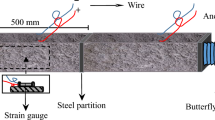Abstract
The influence of multi-scale porosity of fibre reinforcements on local permeability is investigated, in order to determine the possibility of simplifying permeability models for more efficient permeability calculations. Unit cell models of a biaxial Non-Crimp Fabric are developed and used to investigate, whether or not the porous bundles can be excluded, when modelling the local permeability. Numerical accuracy of calculations is controlled to guarantee the quality of the results and the conclusions drawn from them. It is found that fibre bundles with high fibre density can be excluded from permeability models, while bundles with low fibre volume fractions need to be included. A new method to model the local permeability of multi-scale reinforcements is developed and verified for low fibre density in the bundles. In this method, the effects of the flow inside the fibre bundles are included through modifications of the boundary conditions of a single-scale model representing the interbundle regions. The local permeability of multi-scale reinforcements can, therefore, be calculated by models with simplified fluid domains for all fibre bundle porosities, instead of being calculated by models consisting of the entire multi-scale geometry.
Similar content being viewed by others
References
Batchelor G.K. (2000). An introduction to fluid mechanics. Cambridge University Press, London
Bechtold G. and Ye L. (2003). Influence of fibre distribution on the transverse flow permeability in fibre bundles. Compos. Sci. Technol. 63: 2069–2079
Binétruy C., Hilaire B. and Pabiot J. (1997). Interactions between flows occurring inside and outside fabric tows during RTM. Composite Sci. Technol. 57: 587–596
Cai Z. and Berdichevsky A.L. (1993). Numerical simulation on the permeability variations of a fiber assembly. Polym. Compos. 14: 529–539
Gebart B.R. (1992). Permeability of unidirectional reinforcements for RTM. J. Compos. Mater. 26: 1100–1133
Hu J., Liu Y. and Shao X. (2003). Effect of stitches on the permeability of interbundles channels in stitched fabrics. Text.Res. J. 73: 691–699
Lundström T.S. (2000). The permeability of non-crimp stitched fabrics. Composites: Part A 31: 1345–1353
Lundström T.S. and Gebart B.R. (1995). Effect of perturbation of fibre architecture on permeability inside fibre tows. J. Composite Mater. 29: 424–443
Lundström T.S., Toll S. and Håkanson J.M. (2002). Measurements of the permeability tensor of compressed fibre beds. Transport Porous Media 47: 363–380
Lundström T.S., Frishfelds V. and Jakovics A. (2004). A statistical approach to the permeability of clustered fibre reinforcements. J. Composite Mater. 38: 1137–1149
Ngo N.D. and Tamma K.K. (2001). Microscale permeability predictions of porous fibrous media. Int. J. Heat Mass Transfer 44: 3135–3145
Nordlund, M., Lundström, T.S.: Numerical calculations of the permeability of non-crimp fabrics. In: proceedings of ICCM 14, paper 1080 (2003)
Nordlund M. and Lundström T.S. (2005). Numerical study of the local permeability of noncrimp fabrics. J. Composite Mater. 39: 929–947
Nordlund M., Lundström T.S., Frishfelds V. and Jakovics A. (2006). Permeability network model for non-crimp fabrics. Composites—Part A: Appl. Sci. Manuf. 37: 826–835
Oberkampf W.L. and Trucano T.G. (2002). Verification and validation in computational fluid dynamics. Prog. Aerosp. Sci. 38: 209–272
Papathanasiou T.D. (1996). Structure-oriented micromechanical model for viscous flow through square arrays of fibre clusters. Compos. Sci. Technol. 56: 1055–1069
Parnas R.S., Howard J.G., Luce T.L. and Advani S.G. (1995). Permeability characterization. Part 1: a proposed standard reference fabric for permeability. Polym. Compos. 16: 429–445
Pillai K.M. and Advani S.G. (1995). Numerical and analytical study to estimate the effect of two length scales upon the permeability of a fibrous porous medium. Transport Porous Media 21: 1–17
Ranganathan S., Phelan F.R. and Advani S.G. (1996). A generalized model for the transverse fluid permeability in unidirectional fibrous media. Poly. Compos. 17: 222–230
Roache P.J. (1997). Quantification of uncertainty in computational fluid dynamics. Ann. Rev. Fluid Mech. 29: 123–160
Simacek P. and Advani S.G. (1996). Permeability model for a woven fabric. Polym. Compos. 17: 887–899
Song Y.S., Chung T.J., Kang T.J. and Youn J.R. (2004). Prediction of permeability tensor for three dimensional circular braided perform by applying a finite volume method to a unit cell. Compos. Sci. Technol. 64: 129–1636
Spaid M.A.A. and Phelan F.R. (1997). Lattice Boltzmann methods for modeling microscale flow in fibrous porous media. Phys. Fluids 9: 2468–2474
Author information
Authors and Affiliations
Corresponding author
Rights and permissions
About this article
Cite this article
Nordlund, M., Lundström, T.S. Effect of Multi-Scale Porosity in Local Permeability Modelling of Non-Crimp Fabrics. Transp Porous Med 73, 109–124 (2008). https://doi.org/10.1007/s11242-007-9161-0
Received:
Accepted:
Published:
Issue Date:
DOI: https://doi.org/10.1007/s11242-007-9161-0




